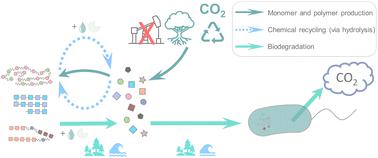当前位置:
X-MOL 学术
›
Green Chem.
›
论文详情
Our official English website, www.x-mol.net, welcomes your feedback! (Note: you will need to create a separate account there.)
Polyester biodegradability: importance and potential for optimisation
Green Chemistry ( IF 9.8 ) Pub Date : 2024-03-05 , DOI: 10.1039/d3gc04489k Yue Wang 1, 2 , Robert-Jan van Putten 3 , Albert Tietema 2 , John R. Parsons 2 , Gert-Jan M. Gruter 1, 3
Green Chemistry ( IF 9.8 ) Pub Date : 2024-03-05 , DOI: 10.1039/d3gc04489k Yue Wang 1, 2 , Robert-Jan van Putten 3 , Albert Tietema 2 , John R. Parsons 2 , Gert-Jan M. Gruter 1, 3
Affiliation

|
To reduce global CO2 emissions in line with EU targets, it is essential that we replace fossil-derived plastics with renewable alternatives. This provides an opportunity to develop novel plastics with improved design features, such as better reusability, recyclability, and environmental biodegradability. Although recycling and reuse of plastics is favoured, this relies heavily on the infrastructure of waste management, which is not consistently advanced on a worldwide scale. Furthermore, today's bulk polyolefin plastics are inherently unsuitable for closed-loop recycling, but the introduction of plastics with enhanced biodegradability could help to combat issues with plastic accumulation, especially for packaging applications. It is also important to recognise that plastics enter the environment through littering, even where the best waste-collection infrastructure is in place. This causes endless environmental accumulation when the plastics are non-(bio)degradable. Biodegradability depends heavily on circumstances; some biodegradable polymers degrade rapidly under tropical conditions in soil, but they may not also degrade at the bottom of the sea. Biodegradable polyesters are theoretically recyclable, and even if mechanical recycling is difficult, they can be broken down to their monomers by hydrolysis for subsequent purification and re-polymerisation. Additionally, both the physical properties and the biodegradability of polyesters are tuneable by varying their building blocks. The relationship between the (chemical) structures/compositions (aromatic, branched, linear, polar/apolar monomers; monomer chain length) and biodegradation/hydrolysis of polyesters is discussed here in the context of the design of biodegradable polyesters.
中文翻译:

聚酯生物降解性:优化的重要性和潜力
为了按照欧盟目标减少全球 CO 2排放,我们必须用可再生替代品取代化石塑料。这为开发具有改进设计特性的新型塑料提供了机会,例如更好的可重复使用性、可回收性和环境生物降解性。尽管塑料的回收和再利用受到青睐,但这在很大程度上依赖于废物管理基础设施,而废物管理基础设施在全球范围内并不始终先进。此外,当今的散装聚烯烃塑料本质上不适合闭环回收,但引入具有增强生物降解性的塑料可能有助于解决塑料积累问题,特别是对于包装应用。同样重要的是要认识到,即使在拥有最好的废物收集基础设施的地方,塑料也会通过乱扔垃圾进入环境。当塑料不可(生物)降解时,这会导致无休止的环境积累。生物降解性在很大程度上取决于环境;一些可生物降解的聚合物在热带条件下在土壤中迅速降解,但它们在海底可能不会降解。可生物降解聚酯理论上是可回收的,即使机械回收很困难,它们也可以通过水解分解成单体,以便随后纯化和重新聚合。此外,聚酯的物理性能和生物降解性都可以通过改变其结构单元来调节。本文在生物可降解聚酯的设计中讨论了聚酯的(化学)结构/成分(芳香族、支化、线性、极性/非极性单体;单体链长)与生物降解/水解之间的关系。
更新日期:2024-03-05
中文翻译:

聚酯生物降解性:优化的重要性和潜力
为了按照欧盟目标减少全球 CO 2排放,我们必须用可再生替代品取代化石塑料。这为开发具有改进设计特性的新型塑料提供了机会,例如更好的可重复使用性、可回收性和环境生物降解性。尽管塑料的回收和再利用受到青睐,但这在很大程度上依赖于废物管理基础设施,而废物管理基础设施在全球范围内并不始终先进。此外,当今的散装聚烯烃塑料本质上不适合闭环回收,但引入具有增强生物降解性的塑料可能有助于解决塑料积累问题,特别是对于包装应用。同样重要的是要认识到,即使在拥有最好的废物收集基础设施的地方,塑料也会通过乱扔垃圾进入环境。当塑料不可(生物)降解时,这会导致无休止的环境积累。生物降解性在很大程度上取决于环境;一些可生物降解的聚合物在热带条件下在土壤中迅速降解,但它们在海底可能不会降解。可生物降解聚酯理论上是可回收的,即使机械回收很困难,它们也可以通过水解分解成单体,以便随后纯化和重新聚合。此外,聚酯的物理性能和生物降解性都可以通过改变其结构单元来调节。本文在生物可降解聚酯的设计中讨论了聚酯的(化学)结构/成分(芳香族、支化、线性、极性/非极性单体;单体链长)与生物降解/水解之间的关系。



























 京公网安备 11010802027423号
京公网安备 11010802027423号